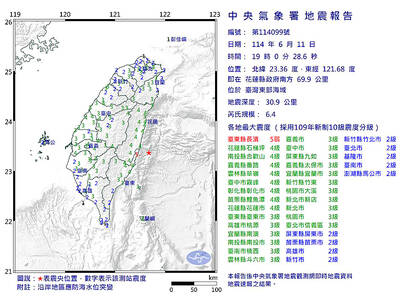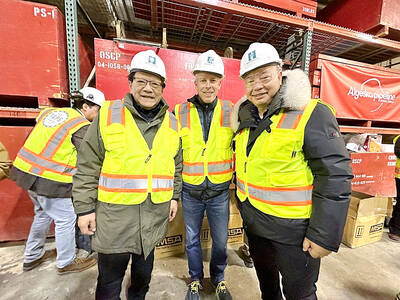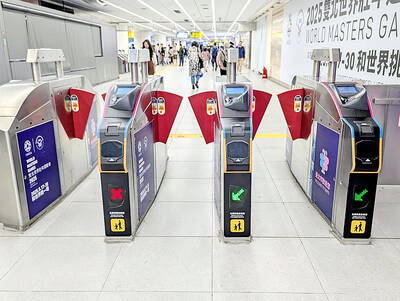A two-stage rocket built by a team from National Chiao Tung University (NCTU) was successfully launched on Sunday, a major step in the development of the nation’s rocket industry.
The 2.5m hybrid rocket was launched from Hsinchu City’s Siangshan Wetlands (香山濕地). The team was able to separate the first-stage propellant when it ran out of fuel and fire the second-stage booster to push the rocket to a height of 1,000m, after which parachutes were deployed to land the rocket, said Wu Jong-shinn (吳宗信), a professor at the university’s Advanced Rocket Research Center.
“It feels so good. We used limited resources to build a propellant system that secured patents in the US, and we successfully completed a launch mission and rocket separation. I am deeply moved to see our team pull this off,” Wu said.
Made with environmentally friendly plastic and glass, the rocket uses a sugar rocket motor for the first-stage propellant, as well as a hybrid propellant system with solid fuel and liquid nitrous oxide for the second-stage booster, Wu said.
The rocket was fitted with a 360-degree camera and a navigation computer system to transmit launch data to ground control, he said.
The launch was to test the rocket’s ignition system and remote communication system. The team has completed more than 20 test launches of small rockets and four test launches of large rockets since 2008.
The launch on Sunday paves the way for the launch of a 9m-high hybrid two-stage rocket later this year which is meant to reach an altitude of 100km to send scientific equipment into space, Wu said.
The center is made up of a group of scientists and students whose dream is to develop fully homegrown launch vehicles to “send Taiwan into space.”
“Although the center has struggled with limited resources, it is one of the leading institutes in the world’s rocketry circle.
The launch was a step forward for Taiwan’s aerospace industry in terms of developing a satellite launch system,” Wu said, adding that the team’s goals include sending personal satellites into space.
The center, which is not publicly funded, has raised NT$9 million (US$267,300), and aims to raise another NT$7 million by the end of this year for research and operations, Wu said, calling on the public to contribute to their space mission.

A magnitude 6.4 earthquake struck off the coast of Hualien County in eastern Taiwan at 7pm yesterday, the Central Weather Administration (CWA) said. The epicenter of the temblor was at sea, about 69.9km south of Hualien County Hall, at a depth of 30.9km, it said. There were no immediate reports of damage resulting from the quake. The earthquake’s intensity, which gauges the actual effect of a temblor, was highest in Taitung County’s Changbin Township (長濱), where it measured 5 on Taiwan’s seven-tier intensity scale. The quake also measured an intensity of 4 in Hualien, Nantou, Chiayi, Yunlin, Changhua and Miaoli counties, as well as

Credit departments of farmers’ and fishers’ associations blocked a total of more than NT$180 million (US$6.01 million) from being lost to scams last year, National Police Agency (NPA) data showed. The Agricultural Finance Agency (AFA) said last week that staff of farmers’ and fishers’ associations’ credit departments are required to implement fraud prevention measures when they serve clients at the counter. They would ask clients about personal financial management activities whenever they suspect there might be a fraud situation, and would immediately report the incident to local authorities, which would send police officers to the site to help, it said. NPA data showed

ENERGY RESILIENCE: Although Alaska is open for investments, Taiwan is sourcing its gas from the Middle East, and the sea routes carry risks, Ho Cheng-hui said US government officials’ high-profile reception of a Taiwanese representative at the Alaska Sustainable Energy Conference indicated the emergence of an Indo-Pacific energy resilience alliance, an academic said. Presidential Office Secretary-General Pan Men-an (潘孟安) attended the conference in Alaska on Thursday last week at the invitation of the US government. Pan visited oil and gas facilities with senior US officials, including US Secretary of the Interior Doug Burgum, US Secretary of Energy Chris Wright, Alaska Governor Mike Dunleavy and US Senator Daniel Sullivan. Pan attending the conference on behalf of President William Lai (賴清德) shows a significant elevation in diplomatic representation,

The Taipei MRT is to begin accepting mobile payment services in the fall, Taipei Rapid Transit Corp said on Saturday. When the company finishes the installation of new payment units at ticketing gates in October, MRT passengers can use credit cards, Apple Pay, Google Pay and Samsung Pay, the operator said. In addition, the MRT would also provide QR payment codes — which would be compatible with Line Pay, Jkopay, iPass Money, PXPay Plus, EasyWallet, iCash Pay, Taiwan Pay and Taishin Pay — to access the railway system. Currently, passengers can access the Taipei MRT by buying a single-journey token or using EasyCard,